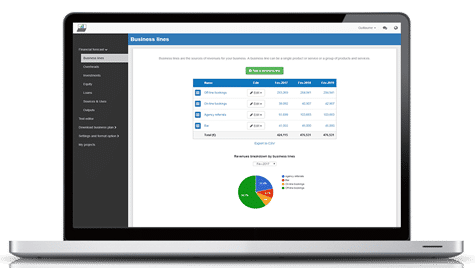How to open a cricket ball manufacturer?
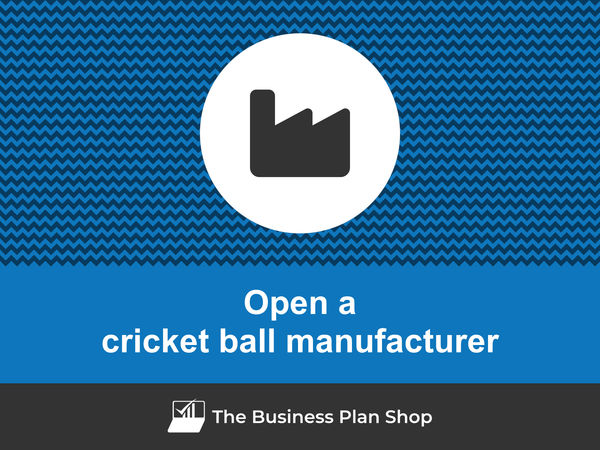
Are you keen to open a cricket ball manufacturing business but don't know where to begin? Then you're in luck because this guide will lead you through all the steps required to check if your business idea can be profitable and, if so, turn it into a reality.
Our guide is for prospective entrepreneurs who are thinking about starting a cricket ball manufacturing business no matter how far they are in their journey - whether you’re just thinking about it or in the middle of market research this guide will be useful to you.
Think of this as your blueprint: we cover everything you need to know about opening a cricket ball manufacturing business and what key decisions you’ll need to make along the way.
Ready? Let’s get started!
What is the business model of a cricket ball manufacturing business?
Before thinking about starting a cricket ball manufacturing business, you'll need to have a solid understanding of its business model (how it generates profits) and how the business operates on a daily basis.
Doing so will help you decide whether or not this is the right business idea for you, given your skillset, personal savings, and lifestyle choices.
Looking at the business model in detail will also enable you to form an initial view of the potential for growth and profitability, and to check that it matches your level of ambition.
The easiest ways to acquire insights into how a cricket ball manufacturing business works are to:
- Speak with cricket ball manufacturing business owners
- Undertake work experience with a successful cricket ball manufacturing business
- Participate in a training course
Speak with cricket ball manufacturing business owners
Talking to seasoned entrepreneurs who have also set up a cricket ball manufacturing business will enable you to gain practical advice based on their experience and hindsight.
Learning from others' mistakes not only saves you time and money, but also enhances the likelihood of your venture becoming a financial success.
Undertake work experience with a successful cricket ball manufacturing business
Gaining hands-on experience in a cricket ball manufacturing business provides insights into the day-to-day operations, and challenges specific to the activity.
This firsthand knowledge is crucial for effective planning and management if you decide to start your own cricket ball manufacturing business.
You'll also realise if the working hours suit your lifestyle. For many entrepreneurs, this can be a "make or break" situation, especially if they have children to look after.
First-hand experience will not only ensure that this is the right business opportunity for you, but will also enable you to meet valuable contacts and gain a better understanding of customer expectations and key success factors which will likely prove advantageous when launching your own cricket ball manufacturing business.
Participate in a training course
Undertaking training within your chosen industry is another way to get a feel for how a cricket ball manufacturing business works before deciding to pursue a new venture.
Whichever approach you go for to gain insights before starting your cricket ball manufacturing business, make sure you familiarise yourself with:
- The expertise needed to run the business successfully (do you have the skills required?)
- How a week of running a cricket ball manufacturing business might look like (does this fit with your personal situation?)
- The potential turnover of your cricket ball manufacturing business and long-term growth prospects (does this match your ambition?)
- The likely course of action if you decide to sell the company or retire (it's never too early to consider your exit)
At the end of this stage, you should be able to decide whether opening a cricket ball manufacturing business is the right business idea for you given your current personal situation (skills, desires, money, family, etc.).
Can your business idea be profitable?
Just enter your data and let The Business Plan Shop crunch the numbers. We will tell if your business idea can generate profits and cash flows, and how much you need to get started.
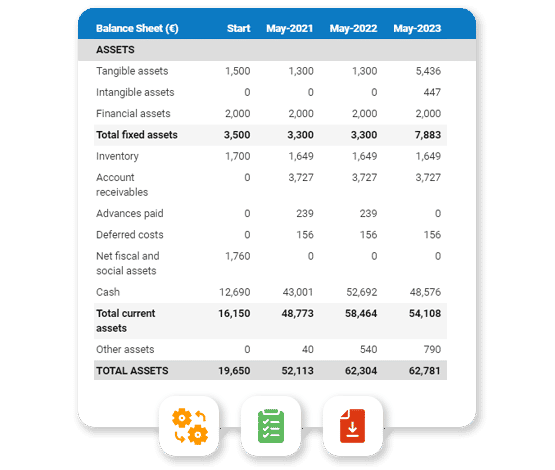
Assembling your cricket ball manufacturing business's founding team
The next step to opening your cricket ball manufacturing business is to think about the ideal founding team, or to decide to go in alone.
Starting and growing a successful business doesn't have to be a solo journey and setting up a cricket ball manufacturing business with several co-founders is generally easier. The business benefits from a management team with a wider skillset, decisions are made together, and the financial risk is shared among the partners, making the journey more collaborative and less daunting.
But, running a business with several partners brings its own challenges. Disagreements between co-founders are quite common, and these can pose risks to the business. That's why it's crucial to consider all aspects before starting your own business.
We won't go into too much detail here, as this is a complex topic that deserves its own guide, but we do recommend that you ask yourself the following questions:
- What is the ideal number of co-founders for this venture?
- Are you on the same wavelength as your potential partners in terms of vision and ambition?
- How will you deal with potential failure?
Let's look at each of these questions in more detail.
What is the ideal number of co-founders for this venture?
To answer this question you will need to consider the following:
- What skills do you need to run the business? Are you lacking any?
- How much startup capital do you need? How much do you have?
- How are key decisions going to be made? - It is usually advisable to have an odd number of partners (or a majority shareholder) to help break the tie.
Put simply, your co-founders contribute skills, capital, or both. Increasing the number of partners becomes advantageous when there is a deficiency in either of these resources.
Are you on the same wavelength as your potential partners in terms of vision and ambition?
Your business partners should share the same short and long-term vision, be it business expansion or social responsibility, to avoid future frustrations and simplify decision-making. Different views are natural, but alignment is ideal.
In any case, you should think of having an exit mechanism in place in case one of the partners wants to move on.
How will you deal with potential failure?
We wish you nothing but success when starting up and growing your cricket ball manufacturing business, but it's always wise to have a backup in case things don't go as planned.
How you deal with a potential failure can vary significantly based on the relationship you have with your business partner (close friend, spouse, ex-colleague, etc.) and the personal circumstances of each of you.
For instance, starting a business with your spouse might seem appealing, but if it doesn't succeed, you risk losing 100% of the household income at once, which could be stressful.
Similarly, going into a partnership with a friend can put pressure on the friendship in the event of failure or when you need to make difficult decisions.
There is no wrong answer, but it is essential to carefully evaluate your options before starting up to ensure you're well-prepared for any potential outcomes.
Is there room for another cricket ball manufacturing business on the market?
The next step in starting a cricket ball manufacturing business is to undertake market research. Now, let's delve into what this entails.
The objectives of market research
The goal here is straightforward: evaluate the demand for your business and determine if there's an opportunity to be seized.
One of the key points of your market analysis will be to ensure that the market is not saturated by competing offers.
The market research to open your cricket ball manufacturing business will also help you to define a concept and market positioning likely to appeal to your target clientele.
Finally, your analysis will provide you with the data you need to assess the revenue potential of your future business.
Let's take a look at how to carry out your market research.
Evaluating key trends in the sector
Market research for a cricket ball manufacturing business usually begins with an analysis of the sector in order to develop a solid understanding of its key players, and recent trends.
Assessing the demand
After the sector analysis comes demand analysis. Demand for a cricket ball manufacturing business refers to customers likely to consume the products and services offered by your company or its competitors.
Looking at the demand will enable you to gain insights into the desires and needs expressed by your future customers and their observed purchasing habits.
To be relevant, your demand analysis must be targeted to the geographic area(s) served by your company.
Your demand analysis should highlight the following points:
- Who buys the type of products and services you sell?
- How many potential customers are there in the geographical area(s) targeted by your company?
- What are their needs and expectations?
- What are their purchasing habits?
- How much do they spend on average?
- What are the main customer segments and their characteristics?
- How to communicate and promote the company's offer to reach each segment?
Analyzing demand helps pinpoint customer segments your cricket ball manufacturing business could target and determines the products or services that will meet their expectations.
Assessing the supply
Once you have a clear vision of who your potential customers are and what they want, the next step is to look at your competitors.
Amongst other things, you’ll need to ask yourself:
- What brands are competing directly/indirectly against your cricket ball manufacturing business?
- How many competitors are there in the market?
- Where are they located in relation to your company's location?
- What will be the balance of power between you and your competitors?
- What types of services and products do they offer? At what price?
- Are they targeting the same customers as you?
- How do they promote themselves?
- Which concepts seem to appeal most to customers?
- Which competitors seem to be doing best?
The aim of your competitive analysis will be to identify who is likely to overshadow you, and to find a way to differentiate yourself (more on this see below).
Regulations
Market research is also an opportunity to look at the regulations and conditions required to do business.
Ask yourself the following questions:
- Do you need a special degree to open a cricket ball manufacturing business?
- Are there necessary licences or permits?
- What are the main laws applicable to your future business?
At this stage, your analysis of the regulations should be carried out at a high level, to familiarize yourself with any rules and procedures, and above all to ensure that you meet the necessary conditions for carrying out the activity before going any further.
You will have the opportunity to come back to the regulation afterwards with your lawyer when your project is at a more advanced stage.
Take stock of the lessons learned from your market analysis
Market research should give you a definitive idea of your business idea's chances of commercial success.
Ideally, the conclusion is that there is a market opportunity because one or more customer segments are currently underserved by the competition.
On the other hand, the conclusion may be that the market is already taken. In this case, don't panic: the first piece of good news is that you're not going to spend several years working hard on a project that has no chance of succeeding. The second is that there's no shortage of ideas out there: at The Business Plan Shop, we've identified over 1,300 business start-up ideas, so you're bound to find something that will work.
Need a convincing business plan?
The Business Plan Shop makes it easy to create a financial forecast and write a business plan to help convince investors that your business idea can be profitable.
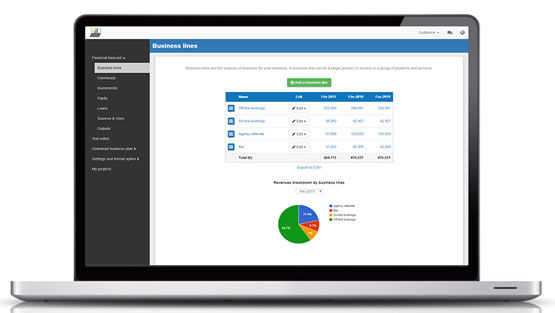
Choosing the right concept and positioning for your cricket ball manufacturing business
Once your market research is completed, it's time to consider the type of cricket ball manufacturing business you want to open and define precisely your company's market positioning in order to capitalise on the opportunity you identified during your market research.
Market positioning refers to the place your product and service offering occupies in customers' minds and how they differ from competing products and services. Being perceived as the premium solution, for example.
There are four questions you need to consider:
- How will you compete with and differentiate yourself from competitors already on the market?
- Is it better to start or buy a cricket ball manufacturing business already in operation?
- How will you validate your concept and market positioning?
Let's look at each of these in a little more detail.
How will you compete with and differentiate yourself from competitors already on the market?
When you choose to start up a cricket ball manufacturing business, you are at a disadvantage compared to your rivals who have an established presence on the market.
Your competitors have a reputation, a loyal customer base and a solid team already in place, whereas you're starting from scratch...
Entering the market and taking market share from your competitors won't happen automatically, so it's important to carefully consider how you plan to establish your presence.
There are four questions to consider here:
- Can you avoid direct competition by targeting a customer segment that is currently poorly served by other players in the market?
- Can you offer something unique or complementary to what is already available on the market?
- How will you build a sustainable competitive advantage for your cricket ball manufacturing business?
- Do you have the resources to compete with well-established competitors on your own, or would it be wiser to explore alternative options?
Also, think about how your competitors will react to your arrival in their market.
Is it better to start or buy a cricket ball manufacturing business already in operation?
An alternative to opening a new business is to take over a cricket ball manufacturing business already trading.
Purchasing an existing cricket ball manufacturing business means you get a loyal customer base and an efficient team. It also avoids disrupting the equilibrium in the market by introducing a new player.
A takeover hugely reduces the risk of the business failing compared to starting a new business, whilst giving you the freedom to change the market positioning of the business taken over if you wish.
This makes buying an existing cricket ball manufacturing business a solid alternative to opening your own.
However, buying a business requires more capital compared to starting a cricket ball manufacturing business from scratch, as you will need to purchase the business from its current owner.
How will you validate your concept and market positioning?
Regardless of how you choose to establish your business, it's crucial to make sure that the way you position your company aligns with the expectations of your target market.
To achieve this, you'll have to meet with your potential customers to showcase your products or services and get their feedback.
Deciding where to base your cricket ball manufacturing business
The next step to opening a cricket ball manufacturing business is deciding where you want to set up your business.
Choosing the right location for your business is like finding the perfect stage for a play. Without it, your business may lack the spotlight it deserves.
Whilst there is no “perfect” location for your cricket ball manufacturing business, one that meets as many of the following factors as possible could be ideal:
- Visibility and foot traffic: This is important for a cricket ball manufacturing business as it will attract potential customers and increase brand awareness. This can be achieved by locating the business in a busy area or near popular sports facilities where there is high foot traffic.
- Parking space, road and public transport accessibility: This is important for employees and customers to easily access the location. It is also necessary for efficient transportation of raw materials and finished products.
- Availability of skilled labor: A cricket ball manufacturing business requires skilled labor for the production process. It is important to locate the business in an area where there is a pool of skilled workers or the ability to attract skilled workers.
- Competitor presence: It is important to consider the presence of competitors in the area. Being located near competitors can help with market research and understanding the demand for different types of cricket balls.
This list is obviously not exhaustive and will have to be adapted to the particularities of your project.
Once you’ve considered the factors above, it’s important to think about the budget that your startup has at its disposal. You’ll need to find a location that meets your business requirements but is affordable enough, especially short-term.
If you opt for renting instead of buying your premises, make sure to take into account the terms of the lease, including aspects such as the duration, rent increase, renewal, and so on.
The lease contractual terms vary greatly from country to country, so be sure to check the terms applicable to your situation and have your lease reviewed by your lawyer before signing.
Need inspiration for your business plan?
Avoid writer's block and draft your own business plan in no time by drawing inspiration from dozens of business plan templates.

Decide on a legal form for your cricket ball manufacturing business
It's now time to think about the legal structure for your cricket ball manufacturing business.
The legal form of a business simply means the legal structure it operates under. This structure outlines how the business is set up and defines its legal obligations and responsibilities.
What are the most common legal structures?
Naturally, the names and intricacies of business structures differ by country. However, they typically fit into two main categories:
- Individual businesses
- Companies
Individual businesses
Individual businesses are usually a good fit for self-employed individuals and freelancers who want limited administrative work. These types of entrepreneurs are commonly referred to as sole traders or sole proprietorships.
As mentioned above, the main benefit of being a sole trader is that minimal paperwork is required to launch and operate the business. Tax calculations are also relatively simple and annual accounts are not always required (and when they are, usually don't need to be audited) which saves a bit of time and money on bookkeeping and accounting fees.
Decision-making is also easy as the final decision is fully dependent on the sole trader (even if employees are hired).
However, being a sole trader also has drawbacks. The main disadvantage is that there is no separation between the individual running day-to-day operations and the business.
This means that if the business were to file for bankruptcy or legal disputes were to arise, the individual would be liable for any debts and their personal assets subsequently at risk. In essence, sole traders have unlimited liability.
This also means that profits earned by the business are usually taxed under the personal income tax category of the sole trader.
Another drawback is that sole traders might find it harder to finance their business. Debt (bank loan for example) is likely to be the only source of external financing given that the business doesn't have a share capital (effectively preventing equity investors from investing in their business).
Companies
Companies are more flexible and more robust than individual businesses. They are suitable for projects of all sizes and can be formed by one or more individuals, working on their own or with employees.
Unlike individual businesses, companies are recognised as distinct entities that have their own legal personality. Usually, there is also a limited liability which means that founders and investors cannot lose more than the capital they have invested into the business.
This means that there is a clear legal separation between the company and its owners (co-founders and investors), which protects the latter's personal assets in the event of legal disputes or bankruptcy.
Entrepreneurs using companies also gain the advantage of being able to attract equity investment by selling shares in the business.
As you can see companies offer better protection and more financing options, but this comes at a trade-off in terms of red-tape and complexity.
From a taxation perspective, companies are usually liable for corporation tax on their profits, and the income received by the owners running the business is taxed separately (like normal employees).
Normally, companies also have to produce annual accounts, which might have to be audited, and hold general assemblies, among other formalities.
How should I choose my cricket ball manufacturing business's legal setup?
Choosing the right legal setup is often simple once you figure out things like how many partners you'll have, if you hire employees, and how much money you expect to make.
Remember, a great business idea can work well no matter which legal structure you pick. Tax laws change often, so you shouldn't rely too much on getting specific tax benefits from a certain structure when getting started.
You could start by looking at the legal structures most commonly utilised by your competitors. As your idea evolves and you're ready to officially register your business, it's a good idea to confirm your choice using inputs from a lawyer and an accountant.
Can I switch my cricket ball manufacturing business's legal structure if I get it wrong?
Yes, you have the flexibility to change your legal setup later, which might include selling the existing one and adopting a new structure in certain situations. Keep in mind, though, that this restructuring comes with additional expenses, so making the right choice from the start is usually more cost-effective.
Can your business idea be profitable?
Just enter your data and let The Business Plan Shop crunch the numbers. We will tell if your business idea can generate profits and cash flows, and how much you need to get started.

Assess the startup costs for a cricket ball manufacturing business
The next step in creating a cricket ball manufacturing business involves thinking about the equipment and staff needed for the business to operate.
After figuring out what you need for your business, your financial plan will reveal how much money you'll need to start and how much you might make (check below for more details).
Because every venture is distinctive, providing a reliable one-size-fits-all budget for launching a cricket ball manufacturing business without knowing the specifics of your project is not feasible.
Each project has its own particularities (size, concept, location), and only a forecast can show the exact amount required for the initial investment.
The first thing you'll need to consider is the equipment and investments you'll need to get your business up and running.
Startup costs and investments to launch your cricket ball manufacturing business
For a cricket ball manufacturing business, the initial working capital requirements (WCR) and investments could include the following elements:
- Machinery and equipment: This includes items such as ball-making machines, leather cutting machines, stitching machines, and any other specialized equipment needed for the manufacturing process.
- Raw materials inventory: As a cricket ball manufacturing business, you will need to purchase large quantities of leather, cork, and other materials to make the balls. These materials need to be factored into your expenditure forecast.
- Research and development: In order to stay competitive, you may need to invest in research and development to improve the quality and design of your cricket balls. This could include hiring experts, conducting experiments, and purchasing specialized equipment.
- Packaging materials: Packaging is an important aspect of the cricket ball manufacturing process. You will need to invest in materials such as cartons, labels, and printing equipment to ensure your balls are packaged properly and attractively.
- Transportation and logistics: As a manufacturer, you will need to transport your finished products to retailers or distributors. This may require purchasing vehicles, hiring drivers, and investing in logistics software to ensure smooth and efficient delivery.
Of course, you will need to adapt this list to your business specificities.
Staffing plan of a cricket ball manufacturing business
In addition to equipment, you'll also need to consider the human resources required to run the cricket ball manufacturing business on a day-to-day basis.
The number of recruitments you need to plan will depend mainly on the size of your company.
Once again, this list is only indicative and will need to be adjusted according to the specifics of your cricket ball manufacturing business.
Other operating expenses for a cricket ball manufacturing business
While you're thinking about the resources you'll need, it's also a good time to start listing the operating costs you'll need to anticipate for your business.
The main operating costs for a cricket ball manufacturing business may include:
- Staff costs: This includes salaries, wages, and benefits for all employees involved in the manufacturing process, such as production workers, quality control technicians, and warehouse staff.
- Accountancy fees: You will need to hire an accountant to help manage your financial records, prepare tax returns, and provide financial advice for your business. These fees can vary depending on the complexity of your business and the services required.
- Insurance costs: As a manufacturer, you will need to have insurance coverage for your business, including general liability insurance, product liability insurance, and property insurance.
- Software licenses: To streamline your manufacturing process and manage your inventory, you may need to purchase software licenses for production planning, inventory management, and accounting software.
- Banking fees: Your business will have various banking needs, such as opening a business account, processing payments, and obtaining loans. These services may come with fees that you need to budget for.
- Raw materials: This includes the materials needed to make cricket balls, such as leather, cork, and thread. The cost of these materials can vary depending on the quality and quantity needed.
- Packaging materials: You will also need to budget for packaging materials, such as boxes, labels, and packing tape, to ship your cricket balls to customers.
- Utilities: Your manufacturing facility will require electricity, water, and other utilities. You will need to factor in the costs of these services in your operating expenses.
- Rent: If you are not purchasing a facility, you will need to budget for rent payments for your manufacturing space. The cost will depend on the location and size of the facility.
- Maintenance and repairs: Your equipment and machinery will require regular maintenance and occasional repairs. You will need to set aside funds for these expenses to keep your production running smoothly.
- Marketing and advertising: To attract customers and promote your business, you will need to invest in marketing and advertising efforts, such as creating a website, attending trade shows, and running social media campaigns.
- Transportation costs: You may need to transport materials and finished products to and from your manufacturing facility. This could include shipping costs, fuel expenses, and vehicle maintenance.
- Training and development: As your business grows, you may need to invest in training and development programs for your employees to improve their skills and knowledge.
- Taxes and licenses: You will need to pay various taxes, such as income tax and sales tax, as well as obtain necessary licenses and permits for your business.
- Professional fees: You may need to hire outside professionals, such as lawyers or consultants, for specific services related to your business, such as legal advice or market research. These fees should be factored into your operating expenses.
Like for the other examples included in this guide, this list will need to be tailored to your business but should be a good starting point for your budget.
How will I promote my cricket ball manufacturing business's?
The next step to starting a cricket ball manufacturing business is to think about strategies that will help you attract and retain clients.
Consider the following questions:
- How will you attract as many customers as possible?
- How will you build customer loyalty?
- Who will be responsible for advertising and promotion? What budget can be allocated to these activities?
- How many sales and how much revenue can that generate?
Once again, the resources required will depend on your ambitions and the size of your company. But you could potentially action the initiatives below.
Your cricket ball manufacturing business's sales plan will also be affected by variations in consumer demand, like changes in activity during peak holiday seasons, and the dynamics within your competitive environment.
Can your business idea be profitable?
Just enter your data and let The Business Plan Shop crunch the numbers. We will tell if your business idea can generate profits and cash flows, and how much you need to get started.

Build your cricket ball manufacturing business's financial forecast
The next step to start your cricket ball manufacturing business: putting your financial projections together.
What is the financial forecast for a cricket ball manufacturing business?
A forecast is a quantified decision-making document that shows the initial investment required to open a cricket ball manufacturing business and the company's potential profitability and cash flow generation over the next 3 to 5 years.
As you think about your cricket ball manufacturing business idea, the main role of financial projections will be to help you decide whether it makes sense to create the company.
Building a financial forecast helps determine the amount of initial financing required to start your cricket ball manufacturing business.
In fact, creating financial projections is the only way to assess the amount of initial financing you'll need to open your cricket ball manufacturing business, and to make sure your project makes economic and financial sense.
Keep in mind that very few business ideas are financially viable. At The Business Plan Shop, we've seen nearly a million business start-up ideas, and we estimate that less than one in four is economically viable.
Your forecast will therefore require your full attention and constant revision, as your project matures. It's also a good idea to simulate different scenarios to anticipate several possibilities (what happens if your sales take longer than expected to ramp up, for example), so you're ready for all eventualities.
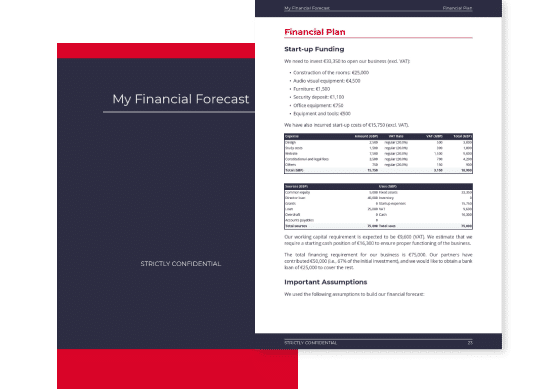
When seeking financing, your forecast will be incorporated into your business plan, which is the document you will use to present your business idea to financial partners. We'll come back to the business plan in more detail later in this guide.
Creating and updating your cricket ball manufacturing business's forecast is an ongoing process. Indeed, having up-to-date financial projections is the only way to maintain visibility over your company's future cash flow and cash position.
Forecasting is, therefore, the financial management tool that will be with you throughout the life of your company. Once you've started trading, you'll need to regularly compare the difference between your actual accounts and your forecasts, and then adjust them to maintain visibility over your future cash flows.
What does a financial forecast look like?
Once ready, your cricket ball manufacturing business forecast will be presented using the financial tables below.
The forecasted profit & loss statement
The profit & loss forecast gives you a clear picture of your business’ expected growth over the first three to five years, and whether it’s likely to be profitable or not.
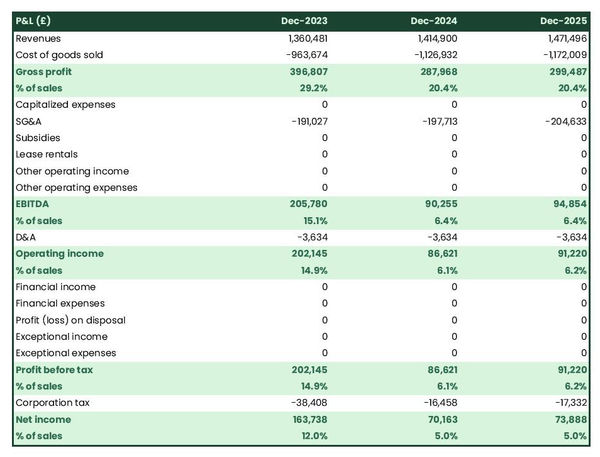
The projected balance sheet
Your cricket ball manufacturing business's forecasted balance sheet enables you to assess your financial structure and working capital requirements.
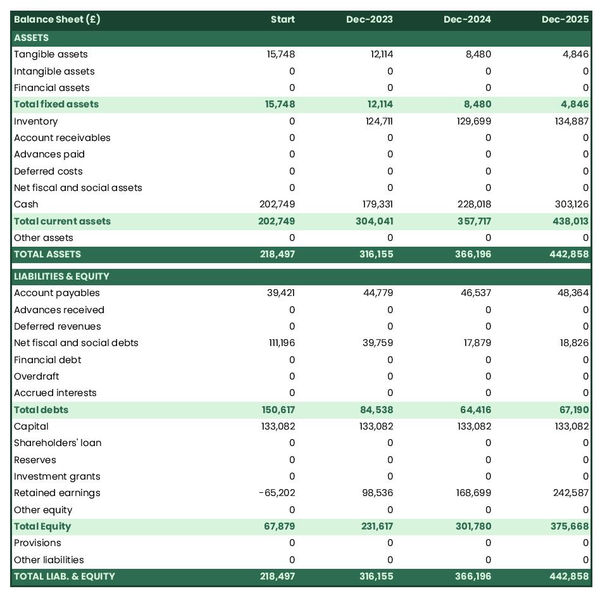
The projected cash flow statement
A projected cash flow statement to start a cricket ball manufacturing business is used to show how much cash the business is expected to generate or consume over the first three years.
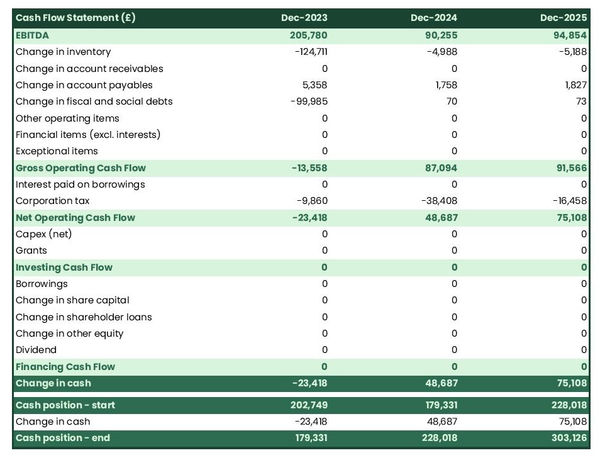
Which solution should you use to make a financial forecast for your cricket ball manufacturing business?
The easiest and safest way to create your cricket ball manufacturing business forecasts is to use an online financial forecasting software, like the one we offer at The Business Plan Shop.
There are several advantages to using professional software:
- You can easily create your financial forecast by letting the software take care of the financial calculations for you without errors
- You have access to complete financial forecast templates
- You get a complete financial forecast ready to be sent to your bank or investors
- The software helps you identify and correct any inconsistencies in your figures
- You can create scenarios to stress-test your forecast's main assumptions to stress-test the robustness of your business model
- After you start trading, you can easily track your actual financial performance against your financial forecast, and recalibrate your forecast to maintain visibility on your future cash flows
- You have a friendly support team on standby to assist you when you are stuck
If you are interested in this type of solution, you can try our forecasting software for free by signing up here.
How do I choose a name and register my cricket ball manufacturing business?
Now that your project of launching a cricket ball manufacturing business is starting to take shape, it's time to look at the name of your business.
Finding the name itself is generally fairly easy. The difficulty lies in registering it.
To prevent this guide from being too long, we won't go into all the criteria you need to take into account when choosing a striking name for your cricket ball manufacturing business. However, try to choose a name that is short and distinctive.
Once you have a name that you like, you need to check that it is available, because you cannot use a name that is identical or similar to that of a competitor: this type of parasitic behaviour is an act of unfair competition for which you risk being taken to court by your competitors.
To avoid any problems, you will need to check the availability of the name:
- Your country's company register
- With the trademark register
- With a domain name reservation company such as GoDaddy
- On an Internet search engine
If the desired name is available, you can start the registration process.
It is common to want to use the trading name as the name of the company, and to have a domain name and a registered trademark that also correspond to this name: Example ® (trading name protected by a registered trademark), Example LTD (legal name of the company), example.com (domain name used by the company).
The problem is that each of these names has to be registered with a different entity, and each entity has its own deadlines:
- Registering a domain name is immediate
- Registering a trademark usually takes at least 3 months (if your application is accepted)
- The time taken to register a new business depends on the country, but it's generally quite fast
How do I go about it?
Well, you have two choices:
- Complete all registrations at the same time and cross your fingers for a smooth process.
- Make sure to secure the domain names and trademarks. Once that's done, wait for confirmation of a successful trademark registration before moving on to register the company.
At The Business Plan Shop, we believe it's essential to prioritize securing your domain names and trademarks over the business name. This is because you have the flexibility to use a different trading name than your legal business name if needed.
Regardless, we suggest discussing this matter with your lawyer (see below in this guide) before making any decisions.
Need inspiration for your business plan?
Avoid writer's block and draft your own business plan in no time by drawing inspiration from dozens of business plan templates.

Deciding upon the corporate identity of your cricket ball manufacturing business
The next step in opening a cricket ball manufacturing business is to look at your company's visual identity.
Your company's “visual identity” plays a crucial role in shaping your brand image. It helps you to be recognizable and to stand out from your competitors.
Although you can define your visual identity yourself, it is generally advisable to call on the services of a designer or marketing agency to achieve a professional result.
At a minimum, you will need to define the following elements:
- Logo
- Brand guidelines
- Business cards
- Website theme
Logo
Your cricket ball manufacturing business's logo allows others to quickly identify your company. It will be used on all your communication media (website, social networks, business cards, etc.) and official documents (invoices, contracts, etc.).
In addition to its design, it's important that your logo is available in a variety of colors, so that it can be seen on all media (white, dark background, etc.).
Brand guidelines
Having brand guidelines enables you to maintain consistency in formatting across all your communications media and official documents.
Brand guidelines define the font (family and size), design and colours used by your brand.
In terms of fonts, for example, you may use Roboto in size 20 for your titles and Lato in size 14 for your texts.
The colours used to represent your brand should generally be limited to five:
- The main colour,
- A secondary colour (the accent),
- A dark background colour (blue or black),
- A grey background colour (to vary from white),
- Possibly another secondary colour.
Business cards
Designing business cards for your cricket ball manufacturing business is a must, as they will allow you to communicate your contact details to your customers, suppliers, partners, potential recruits, etc.
In principle, they will include your logo and the brand guidelines that we mentioned above.
Website theme
In the same way, the theme of your cricket ball manufacturing business website will be based on your logo and the brand guidelines we mentioned above.
This involves defining the look and feel of your site's main graphic elements:
- Buttons,
- Menus,
- Forms,
- Banners,
- Etc.
What legal steps are needed to start a cricket ball manufacturing business?
The next step in opening a cricket ball manufacturing business is to look in detail at the legal and regulatory formalities.
Although it is possible to do the formalities yourself and draft some of the documents detailed here, The Business Plan Shop recommends that you seek advice on these aspects from a law firm.
Registering a trademark and protecting the intellectual property of your cricket ball manufacturing business
One of the first things you need to do here is to protect your company's current and future intellectual property.
One way of doing this is to register a trade mark, as mentioned earlier in this guide. Your lawyer will be in a position to do the formalities for you and to help you select the classes (economic activities) and jurisdictions in which you have an interest in obtaining protection.
Your law firm can also advise you on other ways of protecting your company's intellectual property.
Preparing the legal documents for your cricket ball manufacturing business
Your cricket ball manufacturing business will need a set of legal and contractual documents to operate on a daily basis.
Your exact needs in this respect will depend on the country in which you are launching your cricket ball manufacturing business and the size and legal form envisaged for the company. Once again, we highly recommend having these documents prepared by your lawyer.
As a minimum, we recommend that you have the following documents prepared:
- Employment contracts
- General terms and conditions of sale
- General terms and conditions of use for your website
- Privacy Policy for your website
- Cookie Policy for your website
- Invoices
- Etc.
Applying for licences and permits and registering for various taxes
Here too, the list of licences and business permits required for your business to operate legally will depend on the country in which you have decided to start your cricket ball manufacturing business.
Your law firm will be able to advise you on all the regulations applicable to your business.
Likewise, your accountant will be able to assist you and take care of the formalities involved in complying with the tax authorities.
Need a convincing business plan?
The Business Plan Shop makes it easy to create a financial forecast and write a business plan to help convince investors that your business idea can be profitable.

How do I write a business plan for a cricket ball manufacturing business?
Once you've completed all the above steps, you can start writing the business plan for your cricket ball manufacturing business.
What is a cricket ball manufacturing business's business plan?
The business plan is a document containing:
- The financial forecast (discussed earlier in this guide), highlighting the project's financing requirements and profitability potential,
- A written presentation, which presents your project in detail and provides the necessary context for the reader to assess the relevance and coherence of your forecast.
The business plan is particularly important: it will help you validate your business idea and ensure its coherence and financial viability.
But it's also the document you'll send to your bank and potential investors to present your plan to open a cricket ball manufacturing business and make them want to support you.
So it's best to draw up a professional, reliable and error-free business plan.
How to write a business plan for my cricket ball manufacturing business?
If you're not used to writing business plans, or if you want to save time, a good solution is to use an online business plan software for startups like the one we offer at The Business Plan Shop.
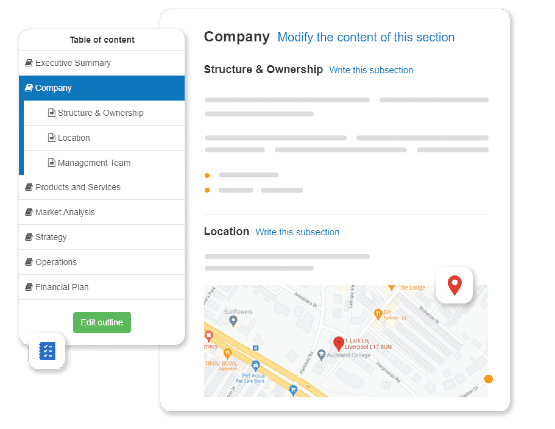
Using The Business Plan Shop to create a business plan for a cricket ball manufacturing business has several advantages:
- You can easily create your financial forecast by letting the software take care of the financial calculations for you without errors
- You are guided through the writing process by detailed instructions and examples for each part of the plan
- You can access a library of dozens of complete startup business plan samples and templates for inspiration
- You get a professional business plan, formatted and ready to be sent to your bank or investors
- You can create scenarios to stress test your forecast's main assumptions
- You can easily track your actual financial performance against your financial forecast by importing accounting data
- You can easily update your forecast as time goes by to maintain visibility on future cash flows
- You have a friendly support team on standby to assist you when you are stuck
Interested? If so, you can try The Business Plan Shop for free by signing up here.
Need a convincing business plan?
The Business Plan Shop makes it easy to create a financial forecast and write a business plan to help convince investors that your business idea can be profitable.

How to raise finance for my cricket ball manufacturing business?
Once your business plan has been drafted, you’ll need to think about how you might secure the financing necessary to open your cricket ball manufacturing business.
The amount of initial financing required will obviously depend on the size of your cricket ball manufacturing business and the country in which you wish to set up.
Businesses have access to two main categories of financing: equity and debt. Let's take a closer look at how they work and what sources are available.
Equity funding
At a high level, the equity of your cricket ball manufacturing business will consist of the money that founders and potential investors will invest to launch the company.
Equity is indispensable as it provides the company with a source of long-term (often permanent) financing and demonstrates the founders' conviction in the company's chances of success, since their investments would be lost in the event of bankruptcy.
Equity investors can generate a return on their investment through dividends (which can only be paid out if the company is profitable) or capital gains on the resale of their shares (if the company is attractive enough to attract a buyer).
As you can see, the equity investors' position is extremely risky, since their capital is at risk and can be lost in the event of bankruptcy, and the company must be profitable or resellable before they can hope to generate a return on their investment.
On the other hand, the return on investment that equity investors can expect to generate by investing in a cricket ball manufacturing business can be very substantial if the company is successful.
This is why equity investors look for start-up ideas with very high growth or profitability potential, in order to offset their risk with a high potential return on investment.
In technical terms, equity includes:
- Share capital and premiums: which represent the amount invested by the shareholders. This capital is considered permanent as it is non-refundable. In return for their investment, shareholders receive shares that entitle them to information, decision-making power (voting in general assembly), and the potential to receive a portion of any dividends distributed by the company.
- Director loans: these are examples of non-permanent capital advanced to the company by the shareholders. This is a more flexible way of injecting some liquidity into your company than doing so as you can repay director loans at any time.
- Reserves: these represent the share of profits set aside to strengthen the company's equity. Allocating a percentage of your profits to the reserves can be mandatory in certain cases (legal or statutory requirement depending on the legal form of your company). Once allocated in reserves, these profits can no longer be distributed as dividends.
- Investment grants: these represent any non-refundable amounts received by the company to help it invest in long-term assets.
- Other equity: which includes the equity items which don't fit in the other categories. Mostly convertible or derivative instruments. For a small business, it is likely that you won't have any other equity items.
The main sources of equity are as follows:
- Money put into the business from the founders' personal savings.
- Money invested by private individuals, which can include business angels, friends, and family members.
- Funds raised through crowdfunding, which can take the form of either equity or donations (often in exchange for a reward).
- Government support to start-ups, for example, loans on favourable terms to help founders build up their start-up capital.
Debt funding
The other way to finance your cricket ball manufacturing business is to borrow. From a financial point of view, the risk/return profile of debt is the opposite of that of equity: lenders' return on investment is guaranteed, but limited.
When it borrows, your company makes a contractual commitment to pay the lenders by interest, and to repay the capital borrowed according to a pre-agreed schedule.
As you can see, the lenders' return on investment is independent of whether or not the company is profitable. In fact, the only risk taken by lenders is the risk of the company going bankrupt.
To avoid this risk, lenders are very cautious, only agreeing to finance when they are convinced that the borrowing company will be able to repay them without problems.
From the point of view of the company and its stakeholders (workforce, customers, suppliers, etc.), debt increases the risk of the venture, since the company is committed to repaying the capital whether or not it is profitable. So there's a certain distrust towards heavily indebted companies.
Companies borrow in two ways:
- Against their assets: this is the most common way of borrowing. The bank finances a percentage of the price of an asset (a vehicle or a building, for example) and takes the asset as collateral. If the company cannot repay, the bank seizes the asset and sells it to limit its losses.
- Against their future cash flows: the bank reviews the company's financial forecast to estimate how much the company can comfortably borrow and repay, and what terms (amount, interest rate, term, etc.) the bank is prepared to offer given the credit risk posed by the company.
When creating a cricket ball manufacturing business, the first option is often the only one available, as lenders are often reluctant to lend on the basis of future cash flows to a structure that has no track record.
The type of assets that can be financed using the first method is also limited. Lenders will want to be sure that they can dispose of foreclosed assets if needed, so they need to be assets that have an established second-hand market.
That being said, terms and conditions also depend on the lender: some banks are prepared to finance riskier projects, and not all have the same view of your company's credit risk. It also depends on the collateral you can offer to reduce risk, and on your relationship with the bank.
In terms of possible sources of borrowing, the main sources here are banks and credit institutions.
In some countries, it's also possible to borrow from private investors (directly or via crowdlending platforms) or other companies, but not everywhere.
Takeaways on how to finance a cricket ball manufacturing business
Multiple options are available to help you raise the initial financing you need to launch your cricket ball manufacturing business.
There are two types of financing available to companies. To open a cricket ball manufacturing business, an equity investment will be required and may be supplemented by bank financing.
What to do after launching my cricket ball manufacturing business?
Launching your cricket ball manufacturing business is the beginning of an exciting entrepreneurial adventure, and the culmination of your efforts to turn your idea into a reality. But this is also when the real work begins.
As you know, nearly half of all new businesses fail, so you'll need to do everything you can to make your business sustainable right from the start.
Estimating the future financial performance of a cricket ball manufacturing business inevitably involves a degree of uncertainty. That's why we recommend simulating several scenarios: a central case with the most likely scenario, an optimistic case, and a pessimistic case designed to test the limits of your business model.
Normally, your company's actual financial performance, observed after you start trading, should fall somewhere between your pessimistic and optimistic cases.
The important thing will be to quickly measure and compare this actual performance with the figures in your forecast to see where you stand, then update the forecast to re-estimate the future cash flows and cash position of your cricket ball manufacturing business.
This forward-looking financial management exercise is the only way to know where you stand and where you're going. And, when your figures fall short of expectations, to quickly implement actions to turn things around before the company runs out of cash.
There's nothing more dangerous than waiting until you have your accounts, which takes up to nine months after the end of your financial year (if you are in the UK, abroad your mileage will vary), to then realize that you're not on the right track and that your cricket ball manufacturing business won't have enough cash to operate over the next twelve months.
This is where using a forecasting solution that integrates actuals vs. forecast tracking, like The Business Plan Shop's financial dashboards do, can simplify the financial management of your business and help reduce the risk associated with your start-up project.
Need inspiration for your business plan?
Avoid writer's block and draft your own business plan in no time by drawing inspiration from dozens of business plan templates.

Key takeaways
- There are 15 key steps to opening a cricket ball manufacturing business.
- Your financial forecast will enable you to accurately assess your initial financing requirements and the potential profitability of your project.
- Your business plan will give your financial partners the context they need to be able to judge the consistency and relevance of your forecast before deciding whether or not to finance the creation of your cricket ball manufacturing business.
- Post-launch, it's essential to have an up-to-date forecast to maintain visibility of your business's future cash flows.
- Using a financial planning and analysis platform that integrates forecasts, business plans and actual performance monitoring, such as The Business Plan Shop, makes the process easier and reduces the risks involved in starting a business.
We hope this guide has helped you understand how to open a cricket ball manufacturing business. Please don't hesitate to contact us if you have any questions or want to share your experience as an entrepreneur.
Also on The Business Plan Shop
Know someone who wants to start a cricket ball manufacturing business? Share this guide with them!

